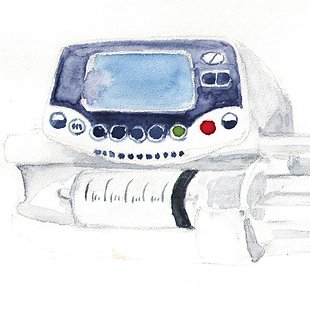Target Controlled Infusion Anaesthesia
In certain situations the use of balanced anaesthesia is not indicated (e.g. malignant hyperthermia). If we cannot use balanced anaesthesia nor regional anaesthesia (due to the characteristics of the surgery) – a TIVA (Total Intravenous Anaesthesia) should come to our minds. And TCI (Target Controlled Infusion) is a way how TIVA can be performed. The advantages of TCI in comparison to manually performed TIVA are for example – easier titration of the anaesthetic agent, it leads to fewer interventions by anaesthesiologist and helps us anticipate the wake up time. The purpose of this algorithm is to introduce the TCI syringe pump, to demonstrate how it works, what the indications are, what parameters are needed and how the complications can be solved with the use of TCI.
Review
This very practical and well-arranged algorithm shows the alternative pathway of general anaesthesia with avoidance of inhalation anesthetics. It clearly shows the general anaesthesia management using Total Intravenous Anaesthesia (TIVA) or Target Controlled Infusion (TCI) in interactive and practical way. It describes and clarifies the individual modes of setting as well as its practical design, including the depth monitoring of such anaesthesia and, from choosing the right pharmacokinetic model to explaining what target concetration is and how patient's parameters . This algorithm is a great and instructive aid to explain the management of general anaesthesia such as TIVA / TCI, which is certainly the future of general anaesthesia management.
Sources
F.SERVIN, J.B CAZALAÀ and JCLEVRON. Anesthetic agents used in TCI: Propofol, Sufentanil, Remifentanil, Alfentanil. 2nd ed. Brézins (Isère): Fresenius Vial, 2009. ISBN 2952563128.
RAMOS LUENGO, A., F. ASENSIO MERINO, M.S. CASTILLA and E. ALONSO RODRIGUEZ. Comparación de la respuesta hemodinámica durante la inducción y la intubación con 2 modelos de infusión controlada por objetivo en el sitio de efecto para propofol: estudio prospectivo y aleatorizado. Revista Española de Anestesiología y Reanimación[online]. 2015, 62(9), 487-494 [cit. 2018-05-05]. DOI: 10.1016/j.redar.2014.12.003. ISSN 00349356. Available at: http://linkinghub.elsevier.com/retrieve/pii/S0034935614003375
CORTÍNEZ, Luis I., Natalia DE LA FUENTE, Douglas J. ELEVELD, Ana OLIVEROS, Fernando CROVARI, Pablo SEPULVEDA, Mauricio IBACACHE and Sandra SOLARI. Performance of Propofol Target-Controlled Infusion Models in the Obese. Anesthesia & Analgesia[online]. 2014, 119(2), 302-310 [cit. 2018-05-05]. DOI: 10.1213/ANE.0000000000000317. ISSN 0003-2999. Available at: https://insights.ovid.com/crossref?an=00000539-201408000-00014
SUN, Yun B., Yong X. LIANG, Miao N. GU and Shi D. WANG. Target-controlled infusion of propofol and anesthesia induction. Journal of Clinical Anesthesia [online]. 2012, 24(1), 75-76 [cit. 2018-05-05]. DOI: 10.1016/j.jclinane.2011.06.012. ISSN 09528180. Available at: http://linkinghub.elsevier.com/retrieve/pii/S0952818011004089
LESLIE, Kate, Ornella CLAVISI and Joshua HARGROVE. Target-controlled infusion versus manually-controlled infusion of propofol for general anaesthesia or sedation in adults. Cochrane Database of Systematic Reviews [online]. , - [cit. 2018-05-05]. DOI: 10.1002/14651858.CD006059.pub3. ISSN 14651858. Available at: http://doi.wiley.com/10.1002/14651858.CD006059.pub3
Related algorithms
- Acute abdomen from a anesthesiological viewpoint
- Anesthesia for thoracic surgery
- Anaesthesia of obese patient
- Preoperative evaluation and patient preparation
- Anaesthesia in the elderly patients
- Anaesthesia of newborn
- Anaesthesia in myotonia congenita Becker
- Anaesthetic Management of Patient with Diabetes Mellitus
- Anaesthetic Management in THA





